Bihar: 20 years of protest
‘The system couldn’t provide for one old woman’
Jalebi Khatoon rarely lets a polythene bag out of her sight. It carries her medicines and vitamins. As she sits on a wooden cot in her thatched verandah, she pulls these out one by one, and tells aloud their prices, leaving an empty vitamin bottle for the last. She ran out of money for that, she says.
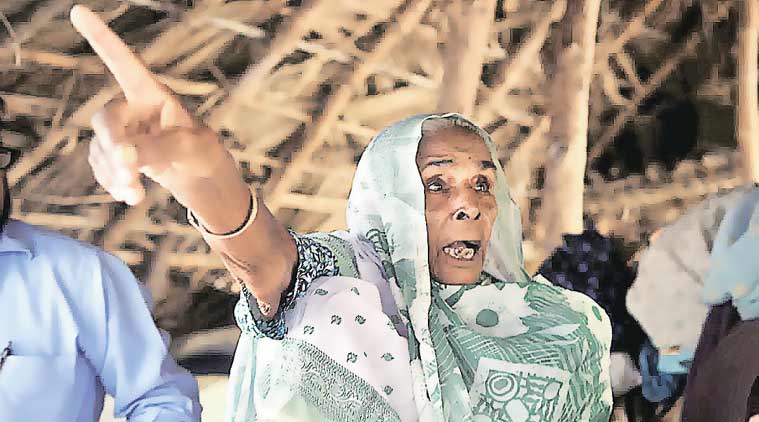 The Bhagalpur riots left 116 Muslims dead in Jalebi Khatoon’s village Tarchha Damuchak. She is the only one to have testified, with her family the sole Muslim one in the village now. (Source: Express photo by Prashant Ravi)
The Bhagalpur riots left 116 Muslims dead in Jalebi Khatoon’s village Tarchha Damuchak. She is the only one to have testified, with her family the sole Muslim one in the village now. (Source: Express photo by Prashant Ravi)
The 80-year-old has been protesting, now for about 20 years, to get her old age pension of Rs 400. The Tarchha Damuchak panchayat never put her name on the beneficiary list, she says, as of all the Muslims who survived the riots in her Laugai village of Gauradih block in Bhagalpur in 1989, she was the only one who testified.
Before the riots, the village had 100-odd Muslim families. The violence left 116 Muslims dead, including Jalebi’s 25-year-old daughter-in-law Nazmum and her grandchildren Sajjad (4) and Tetri (3). She, her son Nazim (53) and his new family are the only Muslims in Laugai.
A few years ago, 22 people were sentenced to life for the killings in the village. Jalebi was the only witness. “I survived the Partition riots and the 1989 riots. My fear of death is gone,” she says.
Nazim now gets Rs 5,000 per month as riots compensation, courtesy the Nitish Kumar government.

Jalebi talks about the riots reluctantly, breaking down every time she comes to the part about her grandchildren. The rioters buried all the victims in a field, and sowed cauliflower over it. By the time the bodies were exhumed and reburied in three separate plots four months later, there was no way to tell apart the remains.
“My husband Videshi Mian died a few years ago. I am supposed to get my widow pension as well. I will keep fighting,” she says, while cursing mukhiya Basuki Yadav.
“You may laugh about my little demand,” she says. “But I have every reason to laugh at all of you and the system… that could not manage to provide for a crippled old woman.”
By Santosh Singh
 This rope bridge, followed by a 5-km walk take Sissen to the nearest road. (Source: Express photo)
This rope bridge, followed by a 5-km walk take Sissen to the nearest road. (Source: Express photo)
Arunachal Pradesh: 28 years of protest
A ‘republic’ seeks a road
Around 250 km from Arunachal’s capital Itanagar lies the ‘Republic of Sissen’. The village decided to give itself that title after waiting and protesting for 28 years for a road connecting it to the rest of the state.
Tajir Siram, a member of the local gram panchayat who is also president of the Sissen Welfare Society, doesn’t understand the problem. “The nearest road is only 5 km away!” he says. Yet, Sissen waits for connectivity since 1987, when Arunachal became a full-fledged state.
Villagers cross the Siang river using a rope bridge with wooden planks, and then walk about 5 km to the nearest road, that takes them to Pasighat, the district headquarters. It was only in 2000 that they got the bridge; until then, they crossed the Siang in boats.
The villagers carry on their protest at home, and every once in a while, take it to Itanagar. Last year, they boycotted both the Lok Sabha and state Assembly elections.
A bitter Siram points out that Sissen even has a link to India’s freedom movement. “It was in our village that a British officer was killed while resisting what the British called the Abor Expedition, back in 1911.”
Incidentally, Sissen produces some of the best quality large cardamom in Arunachal, selling over two tonnes of it earlier this year. “People here also grow oranges, ginger and chillies, fetching every household up to Rs 1 lakh a year,” says Balom Apum, the district horticulture officer at Pasighat. This has enabled many to send their children to schools in Pasighat, where they stay in hostels.
Still, if the prosperous Sissen has no road, even Siram, a member of the ruling Congress, understands why. “We have only 139 votes. The government does not bother.”
By Samudra Gupta Kashyap
 An MNF fighter with the remains of his comrades. (Source: File photo)
An MNF fighter with the remains of his comrades. (Source: File photo)
Mizoram: 29 years of protest
Buried in Aizawl’s dark history
In tiny rundown buildings in and around Aizawl’s main Treasury Square are remnants of a protest whose genesis lies in one of the darkest periods of Indian history. Assembled inside are small associations seeking ex-gratia payment of Rs 5 lakh each for the 2,186 victims of Mizoram’s insurgency years.
They include victims of IAF bombing, the first and last time India used aircraft against its own population, and Delhi’s policy of herding four-fifths of population of Mizo hills into “protected” camps.
Every time a dignitary visits the state, the demand for ex-gratia is put forth, including before BJP president Amit Shah recently. Rs 5 lakh is the amount the Union Home Ministry gave in 2013 as compensation to two women who lost their sanity after being gangraped by soldiers in 1966, at the height of the insurgency.
Lalbiakkima Pautu is vice-president of the Mizoram Martyr Families’ Association. He remembers soldiers beating six men to death inside a school on a Sunday in July 1967. “They screamed till their last breath. My eldest brother was one of them,” says Pautu, then 5.
The Army was looking for Mizo National Front cadres camping in their village, Rullam. That winter, Rullam was burned to the ground and its residents forced into Lungpho, one of the ‘Protected and Progressive Villages’ or PPVs. It was part of a counter-insurgency tactic by then Eastern Command head Lt Gen Sam Manekshaw, to cut off the population from the Mizo National Army, the MNF’s fighting force.
The Peace Accord MNF Returnees Association or PAMRA, made up of 379 members, is pressing the Centre to fulfill the peace accord’s promise to give each returnee a plot of land and decent jobs.
“In 2006, some of our disgruntled colleagues sneaked into Bangladesh to get arms and ammunition and relaunch the insurgency. We helped stop them,” says PAMRA vice-president H L Sangluaia C Lalrotluanga was part of that group of men in their late 50s and early 60s. He holds on to the dream of an independent Mizoram and regrets that his and his comrades’ efforts have not been honoured. “If the younger among us still want to fight for the original dream, us older ones might not be physically capable of joining them,” he warns. “But they will have our full support.”
By Adam Halliday
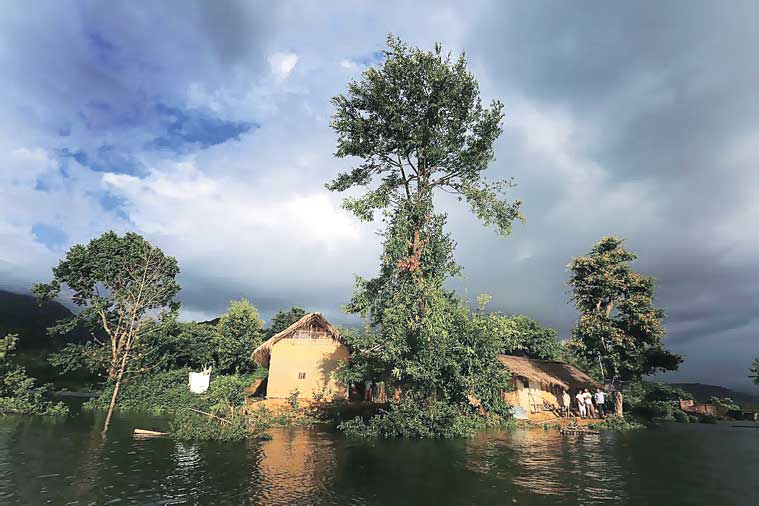 First agricultural fields surrounding Chadong went under water. As their huts filled up, villagers left with the bricks they could retrieve. (Source: Express photo by Deepak Shijagurumayum)
First agricultural fields surrounding Chadong went under water. As their huts filled up, villagers left with the bricks they could retrieve. (Source: Express photo by Deepak Shijagurumayum)
Manipur: 26 years of protest
A village dreads December
Chadong village in Manipur’s Ukhrul district is completely submerged. Dominic Kashung saw it happen, inch by inch. Starting January, large tracts of the agricultural fields surrounding the village gradually went under water. The water crept up and filled their huts next, and then the villagers ran, pulling down the walls of their homes to retrieve bricks to build new ones.
Kashung’s vigil though goes way back, to 1989, when construction of the Mapithel dam began. First conceptualised by the state government in 1976, the dam was approved by the Centre in 1980. Located at the trijunction of Ukhrul, Senapati and Imphal East districts, it was to harness the waters of Manipur’s longest river, the Thoubal, for irrigation and power generation of 7.5 MW.
The submergence area of the 66-m-tall and 1,074-m-long dam was to be 1,777 hectares. Of the 44 villages to be affected, Chadong alone was to be submerged nearly completely.
Kashung was 24 when he began the protest in 1989. It has since grown into the Mapithel Dam Affected Village Organisation, including people from other affected villages and supporters. According to him, 1,215 hectares of the villages’ fields and cultivable land have been submerged. Chadong had a population of a thousand people. His house, located on one of its highest grounds, is among the few spared.
“This was a very fertile village,” rues Kashung. “Each family would earn about Rs 8,000 a month from sale of their produce (including jackfruits, mangoes, strawberries, cherries and leafy vegetables).”
Accusing the government of having no resettlement plan, he says, “A month ago, they marked out land at the top of one of the neighbouring hills. Where are we going to get water from? Where are the connecting roads?”
Five hundred of the villagers have moved to a spot on the eastern side of the hills earmarked by the government, while some have temporarily moved in with relatives. Most have built makeshift homes with tin roofs. “People have been surviving on the stocks of rice they have left and what was given to them by NGOs. We have enough till December when even this will run out,” says Kashung.
By Esha Roy
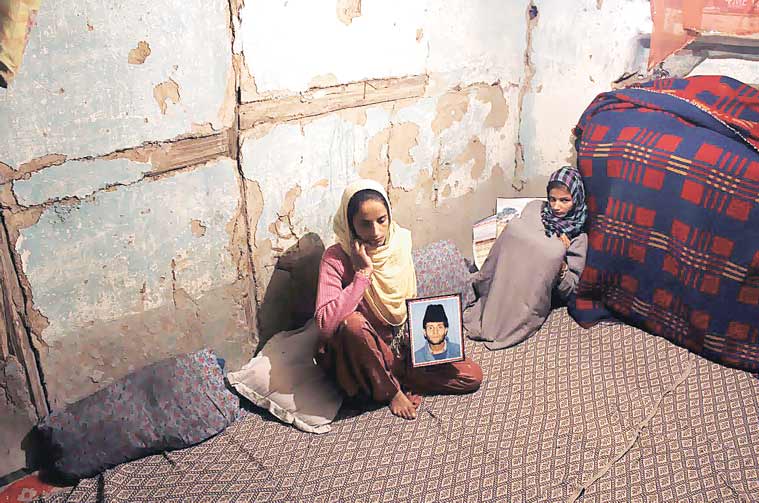 Now she has trouble remembering details of her husband’s case. (Source: Express photo by Shahid Tantray)
Now she has trouble remembering details of her husband’s case. (Source: Express photo by Shahid Tantray)
Jammu & Kashmir: 13 years of protest
Wedded for 3 yrs, ‘half-widow’ for 13
Naseema Akhtar, 30, never misses a monthly protest held at Srinagar’s Municipal Park. Like the other families looking for their dear ones who join her there, Akhtar wants some word on what happened to her husband, who went missing in March 2002.
Syed Anwar Shah was an auto driver, and Akhtar was 17 and pregnant when she became, in a word now accepted in the Valley, one of its “half-widows”.
“I am sure my husband will be back,” she says, sitting with daughter Shazia in their Fateh Kadal, Srinagar, home.
Akhtar was an orphan and with her mother-in-law having died last year, she and Shazia are on their own. Akhtar earns just enough for them to live on.
For a long time, she looked for Shah in jails and police stations, Akhtar sighs. Now she doesn’t remember even the details of the case she filed in 2003 clearly.
By Mir Ehsan
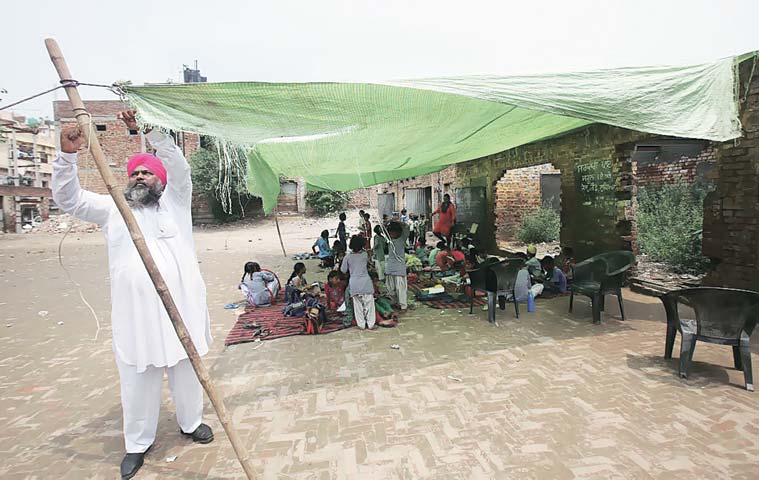 The school refuses to take govt help to buy even the tarpaulin. (Source: Gurmeet Singh)
The school refuses to take govt help to buy even the tarpaulin. (Source: Gurmeet Singh)
Punjab: 19 years of protest
No classrooms, few benches
For 19 years now, Government Primary School, Field Ganj, on Jail Road, Ludhiana, has functioned without a roof. In 1996, the land, registered in the name of a school, was claimed by a neighbouring community hall. A plot measuring 1,660 sq yards, it is worth almost Rs 16 crore now.
Accusing the Education Department and district authorities of not doing enough to protect the school land, the teachers and parents have refused to move. Meanwhile, with the land under dispute, the Education Department has refused to make a school building.
The school currently has 115 students, as many as 40 of them new admissions. A teacher and a volunteer handle all the five classes.
Till she retired in May, Amrik Kaur was both the in-charge of this school and its sweeper. Since her retirement, Pyaara Singh, 53, who was earlier a peon at the school, handles her duties. Singh says they have refused to take a penny from the Education Department, including for the tarpaulin sheet under which classes are held.
“We pay from our own pockets for the sheet that costs Rs 1,100-1,500, changing it almost twice a year,” he says.
“There was no place to cook mid-day meal, so we spent Rs 11,000 and got two rooms covered to prepare food,” adds Amrik Kaur.
The children help tie and untie the sheets daily. “Someone donated benches a few years ago, but these are damaged now. There are only 35 benches, for more than 100 students,” says the teacher, Davinder Kaur.
With the case in court, the school is not even getting Rs 5,000 under the Sarva Shiksha Abhiyaan (SSA). “Every school gets Rs 5,000 for repair and maintenance. We have not received a grant in years,” says Ranjit Singh of the SSA district office.
“We too could have sat on dharnas, but we have taken this route. Our protest is to sit here, without any toilets, drinking water or roof… Let the court speak up,” he says.
By Divya Goyal
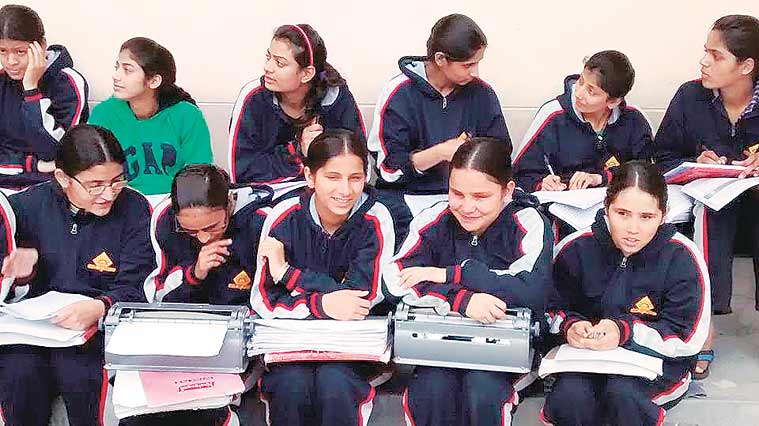 19 disabled girls are now enrolled at Portmore government school. (Source: Express photo)
19 disabled girls are now enrolled at Portmore government school. (Source: Express photo)
Himachal Pradesh: 4 years of protest
Girls pave the way for boys
FIVE visually impaired and 14 hearing disabled girls now study in Government Senior Secondary School, Portmore, Shimla. They have Billo Kumari to thank.
In 2011, the then 18-year-old who topped her Class X exams went to the Portmore school for admission, and was turned away. She approached the Directorate of Education, and later disabled rights activist Ajai Srivastava. A letter by him to Himachal Pradesh High Court Chief Justice Kurian Joseph on behalf of Kumari and two other visually impaired girls, Bhavna Devi from Mandi and Anisha Thakur from Rampur, was treated as a PIL. Soon after, the court ordered the Himachal Education Department to grant the three girls admission.
Later, as Kumari pressed on their case, the court asked the Portmore school to provide the girls hostel facilities as well as an attendant to take care of their daily chores.
With two younger sisters, also visually impaired, and a mentally disabled brother at home, Kumari of Ghumarwin village in Bilaspur district wasn’t fighting this battle just for herself. Their father, an alcoholic, was of little help, and tried to stop her.
Before Kumari, the Portmore school, dating back to before Independence, didn’t give admission to the disabled, citing lack of special educators. Most girls from poor families clearing the special school at Sundernagar run by the state’s Department of Women and Social Empowerment had to drop out of school.
In 2014, Kumari became the first visually impaired student at Shimla’s leading girls college Rajkiya Kanya Mahavidyalaya.
Nisha Thakur, one of the disabled students at Portmore, says their fight is still on. “We are fighting to make university facilities more disabled friendly. Only recently the high court ordered the state government to facilitate free education for all disabled up to the university level.”
The benefits of the protest by the girls have also reached the boys. Senior Secondary Schools for Boys at Nahan (Sirmaur district), Joginder Nagar (Mandi district) and Nagrota Bhawan (Kangra district) are now inclusive institutions.
By Ashwani Sharma
Uttar Pradesh: 19 years of protest
The longest one-man dharna
‘Master’ Vijay Singh has marked a corner for himself in one of the corridors of the Muzaffarnagar collectorate. The 54-year-old has been sitting on a dharna here since 1996 — the longest-ever protest by a single individual in the country, according to the Limca Book of Records. His demand is the release of 4,000 bighas of land in his village Chausana, in neighbouring Shamli district, from a “powerful land mafia”.
Singh’s story began in 1994 when, he says, he was returning home from the government school where he taught economics to Class XII students. “I heard a boy telling his mother, ‘Please borrow aata, let’s eat roti today’. That sentence changed my life,” he says.
Three days later, he resigned from the school. He began with trips to the Muzaffarnagar collectorate, 70 km from Chausana, to study the land records of his village. That’s when he reportedly found that 4,575 bighas in Chausana were in the illegal possession of a group of influential people, whom he calls the “land mafia”.
On February 26, 1996, Singh began his dharna. “This, I thought, would get the officials to act on my letters,” he says.
In 2008, 300 bighas were confiscated from the “mafia” and the state CB-CID filed 136 cases. But there have been no hearings yet and the 300 bighas remain unused.
Till three years ago, his family would send him some money. “I don’t blame them for cutting off ties,” Singh says. “I did nothing for them.” Even the “mafia” has lost interest. “I don’t get threats anymore,” he says.
By Irena Akbar
Karnataka: 24 years of protest
Four cut fingers, many more hands
Since 1991, the tribal Malekudiya community has been demanding ownership papers for land in the Western Ghats that they have been tilling for decades. Last month, the dispute saw another bloody fallout.
On July 26, Sundar Malekudiya, 40, a cancer patient, confronted his neighbour and local landlord in village Neriya, Gopalkrishna Gowda, over attempts by him to trespass into his land. Gowda reacted by allegedly chopping off four fingers of his right hand.
Sundar’s wife Revathi also has a finger missing, from the time in 1999, she says, when Gowda and his four brothers tried to evict tribal families like theirs, claiming the land belonged to them. The court ordered Gowda to pay Rs 10,000 as fine at the time.
The tribals have registered their claims on their land under the Forest Act 2006, but have been turned away by the administration saying it was not forest land.
The attack on Sundar has added a fresh momentum to their protests, with tribals holding daily meetings and marches seeking the arrest of Gowda.
“The Malekudiyas have never been so angry. Not when they were stopped from collecting forest produce, not when they lost land in the name of a national park, not even when police branded them Naxalites and shot their youths,” the CPM, that is backing the Malekudiyas, says.
The tribals allege there is a reason Gowda hasn’t yet been arrested. He is a distant relative of Union Law Minister D V Sadananda Gowda.
By Harsha Raj Gatty
Meghalaya: 25 years of protest
Khasi men vs matrilineal system
Twenty-five years after they began it, a group of Khasi men continues their protest against the community’s matrilineal system, as part of which they shift to their in-laws’ house after marriage and their children carry their mother’s surnames.
“We respect customs. But certain things must change with time,” says Keith Pariat, president of the Syngkhong Rympei Thymmai that is spearheading the protest, and among the few Khasi men to have defied tradition to take on their father’s surname. Tribal laws such as of the Khasis are protected under the Constitution.
According to Pariat, a man loses his “identity and respect” when he moves to his wife’s house, often ending up being dismissed as “shongkha or breeding bull”. His only hope is marrying the youngest daughter of the family, as traditionally she inherits the family property.
The Shillong-based group has over 4,000 members, including some women.
By Samudra Gupta Kashyap
Maharashtra: 15 years of protest
Dalit cultivators vs state govt
Every few years, Kalyan Aran approaches local police and revenue officials and concedes that the cultivation on his one-hectare plot in Gojwada village of Osmanabad district is an encroachment on government land. He requests a penalty be imposed on him, pays a fine and carefully preserves the receipt as evidence of his wrongdoing.
Aran is among an estimated 1,00,000 Dalit cultivators who have encroached on about 3 lakh hectares of government-owned grazing lands, called gairan zameen, ever since Dalit leader Dadasaheb Gaikwad exhorted them to do so in 1960.
Since 2000, about 40,000 families in 2,000 villages of Marathwada have submitted applications to the government staking their claim over the land they cultivate, with receipts dating back to the 1980s.
The struggle brings them together, its unwritten rules ensuring that every farmer’s child attends school. Besides, there isn’t a single recorded instance of farmer suicide.
By Kavitha Iyer
Telangana: 34 years of protest
Dam displaced vs the state
August 14 was the 151st day of agitation by those displaced by the Srisailam dam in Bekkem in Mahbubnagar district, Telangana. They have been protesting for more than 30 years on and off, but this was the longest without a break.
When the dam came up between Mahbubnagar in Telangana region and Kurnool in Andhra region in 1981, more than a thousand families displaced on the Mahbubnagar side were promised government jobs, apart from compensation and housing. Now, they say, they will be happy with just jobs — one for each affected family. Two earlier government orders sanctioning jobs had fallen through.
“My father thought I would get a government job. Instead I ended up selling chickens,” says Rajeshwar Reddy, who lives in Mahbubnagar. To remind the government of their demand, the displaced routinely send over job applications, including as recently as June.
By Sreenivas Janyala
Kerala: 236 days of protest
Villagers vs gold factory
Under 22 weather-beaten flags of different parties, a group of protesters takes turns to sit at a makeshift shamiana. It’s Day 236 of the protest, led by the people of Kakkanchery village in Kerala’s Malappuram district, against a gold manufacturing unit of leading jewellery group Malabar Gold and Diamonds.
The gold factory, spread over 2.25 acres, was initially to come up in a 70-acre complex of the Kerala Industrial Infrastructure Development Corporation (Kinfra). The park is surrounded by residential areas and paddy fields.
Earlier this year, the Malabar group submitted a fresh proposal to the State Pollution Control Board, scaling down the investment. The board then gave it a new licence under the green category. But the protesters won’t back off.
“Gold-making involves highly toxic chemicals,” says the Kakkanchery Environmental Protection Committee.
By Shaju Philip
Chhattisgarh: 8 months of protest
Gram sabhas vs coal mines
This January 20, gram sabhas in Chhattisgarh under the Hasdeo Arand Bachao Samiti passed a resolution saying that since they opposed mining and would never give their land for it, the government must not allot a coal block here. Normally, gram sabhas take such steps after mining rights have been allotted. This was perhaps the first case of preemptory action in India.
The Hasdeo Anand forest has 5.179 billion tonnes of estimated coal reserves, but was declared “no-go” for mining in an MoEF survey of Indian coalfields under the UPA. In 2007, Chhattisgarh also earmarked a large part of Hasdeo Arand as a proposed elephant reserve. But in 2008, it made a U-turn.
“When gram sabhas have passed unanimous resolutions, the government cannot allocate the blocks,” says Alok Shukla of the Chhattisgarh Bachao Andolan.
The zone has known such protests. A few years ago, tribals had held a “coal satyagraha” in Raigarh, extracting coal for personal use.
By Ashutosh Bhardwaj
Tripura: 10 years of protest
Tribals vs govt script
It’s not a protest with many parallels. Tribals in Tripura want to be able to read and write Kokborok in a script other than the “modified” Bengali script the government favours. The script of their choice, which they say accommodates the sounds of the Tibeto-Burman tongues of which Kokborok is a part, is Roman.
A decade ago, the tribal scholars formed the ‘Movement for Kokborok’.
Now the language struggle has also got tinged by Tripuri nationalism. Activists across the Northeast cite Tripura as an example of how an indigenous population can be overwhelmed by outsiders. During Partition, lakhs of mostly Hindu Bengalis came to settle in the state, and tribals now make up just a quarter of Tripura’s population from three-quarters in 1947.
In 1994, Tripura University established a certificate course in Kokborok, later upgraded to a diploma. Only about 20 students undertake the course each year.
